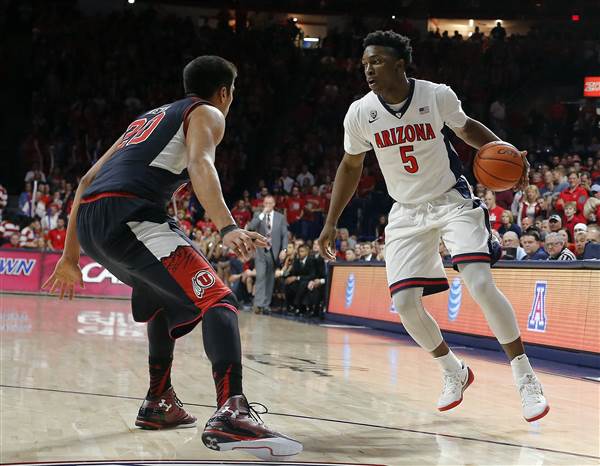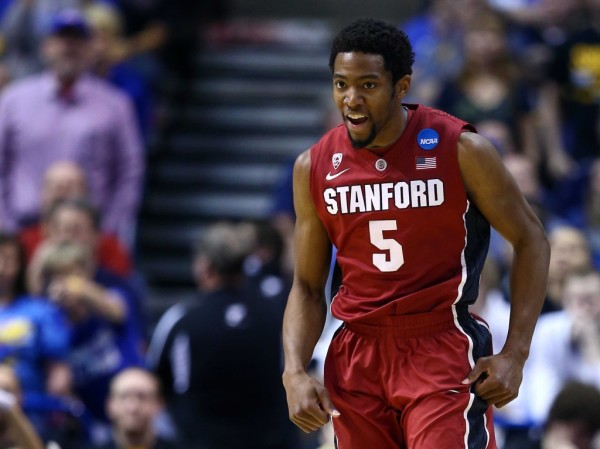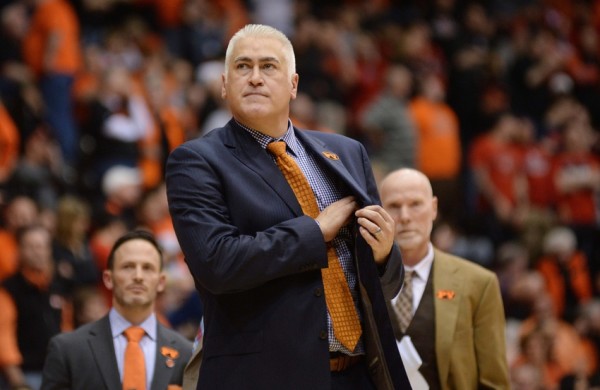A Swing Around the Pac-12 After Five Games
Posted by Andrew Murawa on January 21st, 2015Just a collection of thoughts, compiled over the course of the past two weekends of Pac-12 play.
Arizona – This Utah game actually set up really nicely for the Wildcats. Utah was on a roll and feeling invincible despite the fact that it hadn’t beaten a good team since early December. Arizona, meanwhile, had plenty to prove amid accusations of selfishness and overratedness. The ‘Cats weathered the storm early, rode T.J. McConnell while settling in, and then turned on the juice in the second half. But, really, there are two big takeaways from this game. First, my impression all year long was that this vintage of the Wildcats does not have the high-end defensive ceiling that last year’s team had. And then, I look up on January 17 and they’ve got basically the same defensive efficiency numbers as they had last season and just finished a game where they completely shut down everything Utah wanted to do. This squad still needs to prove an ability to bring that intensity on a regular basis, but they absolutely have the ability to be just about as good defensively as last year’s team (although I still have a concern that they don’t have the type of individual stoppers that they had in Nick Johnson and Aaron Gordon). Offensively, my eyes tell me this team has some problems in the half-court and that, while Stanley Johnson is clearly the team’s most talented player, Sean Miller has yet to figure out a good way to find shots for him. Then I look at the stats and I see that this team is pretty much the same offensively as last year’s group, getting similar percentages of shots from all three ranges on offense. And the best part? They’re still feeling their way around. Make no mistake, Arizona in mid-January is still a top 10 team — maybe top five — and the exciting part is that the Wildcats have enough upside that they could be significantly better by March.

With Stanley Johnson Just Beginning To Reach His Potential, Arizona’s Upside Is Staggering. (Rick Scuteri, AP Photo)
Utah – The Utes lost. Bury ‘em, right? Not so fast, but we do need to have a talk about a couple of players in particular. First Jordan Loveridge, the team’s junior power small forward. What’s to complain about? In the five Pac-12 games since he returned from injury, he’s averaging better than 10 points per game and shooting at a 54.2% eFG rate, knocking in 11-of-24 shots from deep. In that same time frame, he’s taken twice as many shots from behind the arc as he has from inside; he’s attempting free throws at about a third of the rate of his field goal attempts; and he’s grabbing a rebound about every five minutes. In short, Loveridge has gone from being one of the more promising interior players in the conference to a three-point shooting specialist. That’s about all he does anymore. I understand that at 6’6” his upside at the four is limited, and if he is ever going to play in the NBA, it will be at the three. But this is college ball. And while his ability to hit the three and pull bigs away from the hoop is a useful skill, it’s only a fraction of what Loveridge could be doing for this team. For what it’s worth, I promise that this is the last time I will rip a guy with an offensive rating of 115.0 and a three-point percentage of 47.5 percent. The other guy I want to touch on briefly is Jakob Poeltl. We still like him as a player: like his skills; like his effort; like his upside. And sure, NBA scouts love him. But he really needs a lot of work, especially in the weight room. He got pushed around by the Wildcats all night long on Saturday. And if you go back and look at the results, anytime he has gone up against long interior players (San Diego State, Kansas, UNLV, Colorado, Arizona, even BYU), he has struggled. You can’t really throw the ball into him in the post because he doesn’t know what to do with it yet, so you have to rely on him to get his own miss off the glass if he’s going to have any offensive impact, and he’s not strong enough to do that on a regular basis. He’s still an important part of this Utah team, but his major leap forward probably won’t come until next year, at which time he should hopefully still be in college.
Stanford – For some reason, the Cardinal are still a punch line. You hear it all up and down the Pac-12: they’re soft; they’re unpredictable; a Johnny Dawkins-coached team is untrustworthy. And yet, in the past two seasons, they’ve represented their conference with a number of big non-conference wins perhaps better than any other team. They earned another solid win last weekend by handling UConn with ease at home, and then you look at the conference standings and you see the Cardinal right there with only one loss alongside Utah and Arizona. Stanford will host Arizona on Thursday night, so we’ll know more about this team after that game, but I’ll tell you this much: Barring a complete collapse down the stretch, this team is NCAA Tournament-bound. Really, even a 10-8 conference record (which would equate to a 6-7 finish to conference play, with seven of those 13 remaining games at home), the Cardinal would seem to be pretty comfortably in the field.
Washington – It was a rough start to conference play, and that on top of the Stony Brook disaster rightfully caused a flee from the bandwagon. But if you look at what happened in those four games (reminder: a five-point loss, a six-point loss, an overtime loss, and a three-point loss), those games were an aberration in comparison with the rest of the season. Washington’s defense is fifth in the nation in effective field goal percentage allowed, giving up just a 40.5 percent rate on the year; in those four losses, their opponents shot a 46.6% eFG against them. The other thing the Huskies have done well is to outscore their opponents from the foul line. And yet in the three Pac-12 games in that losing streak, the Huskies were outscored from there. For the record, in both wins at home last weekend, the Huskies made more shots from the line than their opponents even attempted. Don’t abandon this ship just yet.
UCLA – The last time we wrote about the Bruins, we were burying them along with seemingly everyone else. Now they’ve got a three-game winning streak, the last two by an average of 18 points per game, and the team is brimming with confidence. A trip to Oregon looms this weekend, though, and given that the only game the Bruins have won outside of the city of Los Angeles was a seventh-place win over a bad UAB team in the Battle 4 Atlantis, let’s just say this team has a lot to prove in the Pacific Northwest. Offensively, UCLA looks light years better than it did during its five-game losing streak, however. There have been a lot of adjustments made, but the big one was to lighten Bryce Alford’s load. UCLA is now letting guys like Kevon Looney, Isaac Hamilton or Norman Powell bring up the ball on occasion, and the half-court offense is no longer simply Alford creating on the fly. After that 0-of-13 from three trip to the Rockies, Alford has recovered with an 11-of-19 from deep mark during the three-game winning streak.
Oregon State – In Craig Robinson’s second of six seasons at Oregon State, the Beavers had a KenPom adjusted defensive efficiency rating of 97.2, roughly the equivalent to allowing 97 points over the course of 100 possessions against the average offensive opponent. That was good for 77th in the nation. While it wasn’t a straight line, from there on out, OSU’s defense went downhill over the remainder of Robinson’s tenure to last year’s nadir of a 107.1 defensive efficiency rating. In Wayne Tinkle’s first season, that adjusted defensive rating has plummeted to 91.6. Why? Everything’s different. Last year, there were no redeeming qualities about the Oregon State defense. Even things that should have been positives – like the length and athleticism of frontcourt guys like Eric Moreland and Devon Collier – was washed away in soft defense lacking any on-ball pressure and anemic defensive rebounding. This year, the Beavers are in the top 25 in opponent’s effective field goal percentage and in defensive turnover percentage, and they’re still in the top 100 in defensive rebounding. They pressure the ball, force bad shots and yet still have the wherewithal and discipline to clean the defensive glass. It all starts with do-everything guard Gary Payton II who is living up to his name with his defensive ability. Despite a 6’3” frame, not only is he #4 in the nation in steal percentage, but he’s also among the top 300 in block percentage and has got to be, inch-for-inch, the best rebounder in the nation. But he’s not the sole different. Backcourt mate Malcolm Duvivier is a terrific perimeter defender as well, while Langston Morris-Walker and Victor Robbins can cause problems with their length on the perimeter as well. And, if you should happen to penetrate the outer shell of the Beaver defense, lengthy shotblockers Daniel Gomis and Jarmal Reid await in the lane to send back shots. The rebirth of the Oregon State defense from a passive afterthought to an aggressive, attacking D is one of the greatest reinventions our game has seen this season.
Oregon – I’m still not sure exactly how good the Ducks are (mostly because I’m quite sure that they’re not very good defensively), but they sure are fun to watch. One of four Pac-12 teams to average at least 68 possessions per game (for comparison’s sake, Oregon State barely squeaks over 60 possessions per game), the Ducks are blessed with the league’s best pure scorer in Joseph Young, spectacular finishers in Elgin Cook and Jordan Bell, versatile offensive threats like Dwayne Benjamin and Dillon Brooks, and then three-point specialists like Jalil Abdul-Bassit and Casey Benson. Anytime the Ducks take the court, they’re capable of getting into and up-and-down, shoot-it-out affair with their opponent.
Colorado – Now, let’s not pretend that the Buffaloes would have been just fine all along if not for injuries, but the losses of Josh Scott (missed four of last five games with back spasms) and Xavier Johnson (missed the Arizona trip plus all but six minutes of the Utah game with ankle injury) have been pretty rough. But, let’s focus on the bright side for a minute, because there is still plenty of talent here, specifically with sophomore wings Tre’Shaun Fletcher and Jaron Hopkins beginning to get their acts together. After getting just 28 total minutes in Colorado’s three games at the Diamond Head Classic, Fletcher has averaged better than 20 minutes per night in conference play. And Hopkins has averaged 29 minutes in that span. They’ve both got similar skills, including end-to-end talent. At 6’7” and 6’6”, both are plenty capable of playing harassing defense on one end, grabbing a strong rebound in traffic, turning immediately up court and initiating transition offense, with the ability to score in traffic or find an open teammate. Both are still somewhat erratic, with tendency to force action and commit turnovers. But with experience, they’ve got the chance to improve the Buffaloes on both end of the court.
Washington State – This is a team who lost at Santa Clara and at home to Idaho in the non-conference. Their best win was a seven-point margin over UC Davis. And here they were with a 3-2 record in conference play. Anybody else have this coming? The Cougars’ success under Ernie Kent so far may get swept under the rug, if only because they’re also in the same conference as overachieving Oregon State, but there is plenty of reason for Wazzu hoops fans to be hopeful for the future. First, there’s the style. After three straight years under 63 possessions per game in the end of the Ken Bone era, the Cougars are now playing 69 possessions a game of crisp offense. Second, there’s the foundation for the future, as sophomores Josh Hawkinson and Ike Iroegbu have had breakout second seasons and figure to be a strong one-two punch for the next couple of seasons. And what if this coaching staff can ever figure out what to do with Que Johnson? The last piece of the puzzle is bringing in fresh blood. Well, on this front, Kent’s still got a long ways to go, with two JuCo kids and a two-star 6’7” center alone among 2015 commitments at this point.
Cal – Four straight conference losses – two at home, two on the road – do not make for good times in Berkeley. After a spectacular start to the season during which Tyrone Wallace was playing at a clear-cut all-conference level, he has now played seven straight games under a 100 ORtg, with a combined 34.3 eFG% over that stretch and a 23:20 assist to turnover ratio. Jordan Mathews has done his best to alleviate some of the pressure on his running mate (he’s got a 63.4 eFG% in conference play and is averaging 21 points per game), but the fact is, this team is completely perimeter-oriented, with less than 30% of their shots coming in the paint. So when one of their perimeter players suffers a dip in efficiency like Wallace has, coupled with the absence of another, as Jabari Bird missed ten games with injury, the offense is bound to take a dive.
Arizona State – Just this.
USC – At some point I promise to take this team seriously. But probably not until sophomore Katin Reinhardt can string together back-to-back games where he shoots better than 50% from the field. On the year, only once has his traditional field goal percentage topped 50% (game one vs. Portland State when he went 5-of-9 in an embarrassing loss). Give him a little extra credit for knocking in threes, and he’s put together three other games this year when his effective field goal percentage was at least than 50%: vs Drexel (2-of-5 from the field with one three – 50 eFG%); vs. Utah State (3-of-8 from the field, with all of those hoops three-pointers – 56.3 eFG%); vs. UCLA (4-of-9 from field, two threes – 55.5 eFG%). If you, like me, thought USC was going to at least show some improvement this season, you probably saw Reinhardt as a potent perimeter scorer for this team. Thus far, that has not come to pass. The fact that he doesn’t even pretend to attempt to defend doesn’t help anything.












































